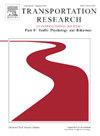头部运动比步行速度更早地预测行人过马路的决定
IF 3.5
2区 工程技术
Q1 PSYCHOLOGY, APPLIED
Transportation Research Part F-Traffic Psychology and Behaviour
Pub Date : 2025-05-31
DOI:10.1016/j.trf.2025.05.015
引用次数: 0
摘要
了解行人过马路时的行为对提高安全至关重要,因为行人是最脆弱的道路使用者,也是最难预测的。之前的研究调查了打算过马路的行人如何评估车辆的速度和距离以接受间隙。然而,很少有人注意到头部运动作为交叉决策的预测因子的作用。行人头部运动除了受过马路意向的影响外,还受到路边接近过程和潜在交通方向的影响,但这两个因素的研究都很少。在这里,我们比较了头部运动和步行速度的预测能力,通过检查行人如何接近十字路口的位置,同时寻找过马路的机会。我们使用全向跑步机和头戴式显示器来研究36名参与者的交叉行为。我们的研究结果表明,在行人注意到汽车后的最初几秒内,头部转向频率比步行速度更能预测行人的过马路决策。随着时间的推移,行走速度变得比头部信息更有用,并在行人穿过路边前不久达到完美的预测能力。这些发现表明,头部方向可以作为穿越初期的预测特征,而行走速度可以作为穿越后期的预测特征。最后,本研究强调了未来研究在更现实条件下调查行人行为的必要性,为自动驾驶中行人保护的行为预测模型提供相关见解。本文章由计算机程序翻译,如有差异,请以英文原文为准。

Head movements predict pedestrian crossing decisions earlier than walking speed
Understanding the behaviour of pedestrians when crossing roads is crucial to improving safety, as pedestrians are the most vulnerable road users, but also the most difficult to predict. Previous research has examined how pedestrians, who intend to cross a road, assess vehicle speed and distance for gap acceptance. However, little attention has been given to the role of head movements as predictor for crossing decisions. Besides by the crossing intention, head movements are also influenced by the approach process to the kerb and the potential traffic directions, but both factors are rarely studied. Here, we compare the predictive power of head movements and walking speed for crossing decisions by examining how pedestrians approach a crossing location while simultaneously looking for crossing opportunities. We used an omnidirectional treadmill combined with a head-mounted display to investigate the crossing behaviour of 36 participants. Our results demonstrate that in the first seconds after pedestrians notice the car, the head-turning frequency is a stronger predictor for the crossing decision than the walking speed. As time passes, the walking speed becomes more useful than the head information and reaches a perfect predictive power shortly before pedestrians cross the kerb. These findings suggest that head orientation could be used as a predictive feature in the initial phase of the crossing and walking speed in the later phase. Ultimately, this research highlights the need for future studies that investigate pedestrian behaviour under more realistic conditions, providing insights relevant to behaviour prediction models for pedestrian protection in automated driving.
求助全文
通过发布文献求助,成功后即可免费获取论文全文。
去求助
来源期刊
CiteScore
7.60
自引率
14.60%
发文量
239
审稿时长
71 days
期刊介绍:
Transportation Research Part F: Traffic Psychology and Behaviour focuses on the behavioural and psychological aspects of traffic and transport. The aim of the journal is to enhance theory development, improve the quality of empirical studies and to stimulate the application of research findings in practice. TRF provides a focus and a means of communication for the considerable amount of research activities that are now being carried out in this field. The journal provides a forum for transportation researchers, psychologists, ergonomists, engineers and policy-makers with an interest in traffic and transport psychology.

 求助内容:
求助内容: 应助结果提醒方式:
应助结果提醒方式:


